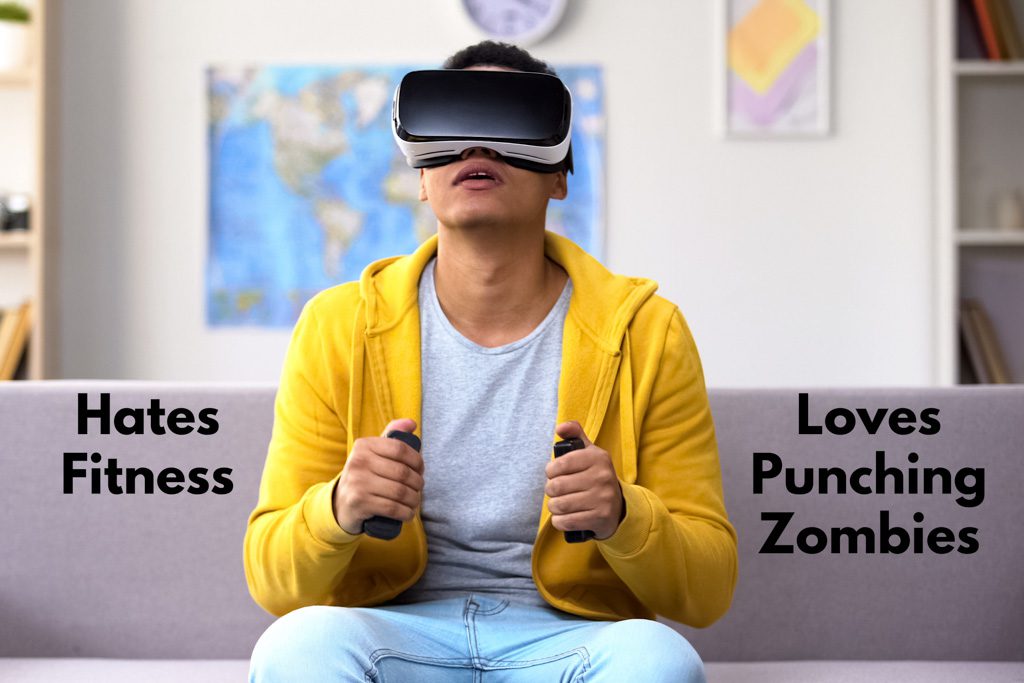Darth Vader’s cardio sucks, but he’s pretty good at the deadlift.
But maybe “Beat Saber” can change that.
As a gym owner or trainer, feel free to make your own joke about virtual reality—VR—fitness games and apps.
After you do, read on to find out why VR fitness might be a good thing for your business.

You and I enjoy working out. We’re weird—at least when compared to the general population.
Most people don’t like burning muscles, pounding hearts and a slight tinge of exercise-induced nausea. They like other stuff: Binging on “Yellowstone,” pwning noobs on “Call of Duty” and “Halo,” and swiping right on Tinder. They like watching “Squid Game,” not actually playing it.
They don’t know who you are and they don’t care. They’re not going to click your ads, they’re not going to watch the CrossFit Games, they don’t want to flip tires, and they literally could not care less about energy systems and squat technique.
To lean on “Star Wars” one more time, if your gym is Earth, these people are out past the Dagobah system in a galaxy far, far away.
Despite those facts, you hold the secret to improved health.
And you just might be able to reach these people with a little help—and some media.
Fitness in The Matrix
VR fitness is now a thing—whether users are actually trying to work out or get tricked into it as they slash glowing arrows with a light saber.
I’ll bring you up to speed in case your gaming experience ended in 1997 when Baron Samedi executed you with a silenced PP7 in “GoldenEye 007” on N64.
Video games have evolved to include VR headsets that place users in immersive environments. It’s a lot like the Holodeck on “Star Trek”—or “The Matrix” if you took the red pill. Gamers also use handheld controllers, gloves, waistbands and even foot-tracking sensors to interact with the digital world.
These systems allow users to play games like “Beat Saber” and “The Climb,” in which they become active by accident, or users can actually pursue fitness with specific games. Check out FitXR on the Oculus Quest platform:
As a trainer or gym owner, it’s going to be really tempting to throw shade on VR fitness. I did.
- “This is just battle ropes without the ropes.”
- “There’s no progressive overload for strength training!”
- “What if you accidentally hit your lamp with an uppercut?”
Feel free to take a second and clear your own pipes of vitriol.
Then check out this dude. He’s got a Rogue safety squat bar in the background and a whack of fitness credentials. He’s creating videos to help people get fit in the virtual world:
To Mock or Make Connections?
Two-Brain founder Chris Cooper has written about how he used to criticize P90X and other programs because they weren’t as effective as training with him. When he realized that these programs were actually a “gateway” to his services, he stopped criticizing.
Instead of telling people that P90X wouldn’t help them build muscle, Chris congratulated them on working on their fitness. He built relationships that eventually created clients when people got sick of doing the same DVD every day and hitting the inevitable plateaus that come when you always do the same routine.
So take Coop’s approach with VR fitness. Instead of making fun of it, ask yourself how you can help people who want to get fit in a virtual world. Connect with them. Apply your expertise and share your knowledge. Then tell them how you can make them even fitter.
And check this out:
FitXR is being marketing to people who don’t ever want to go to a gym. That’s great!
Gaming companies are doing the heavy lifting for you. These companies have entered the cheat code that gives you access to a secret level full of gold coins. They succeeded where the traditional fitness industry failed: They got a huge group of inactive people to get off the couch and shank zombies just in front of it.
You can coach those people, right? Your online coaching and accountability service can easily work “30 minutes of ‘Beat Saber’” into a prescription that would help a person get fit at home.
Write about that—or, better yet, make a video because you already know these people like videos.
The point: You have a chance to make a connection any time anyone is interested in any aspect of movement. Even in a virtual world.
So start thinking outside the Xbox: Use your media to make the connection between movement and your services.

